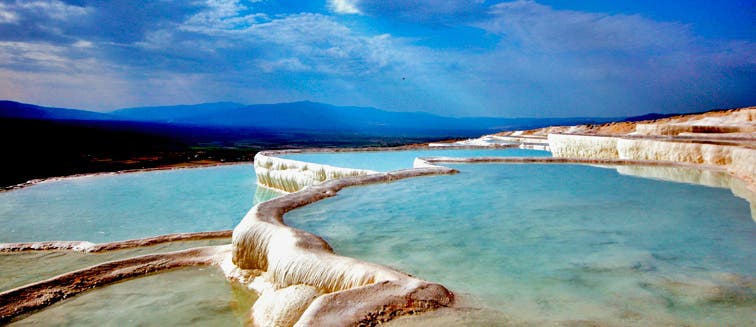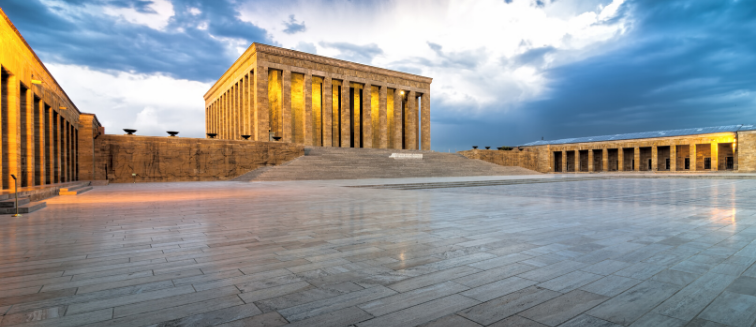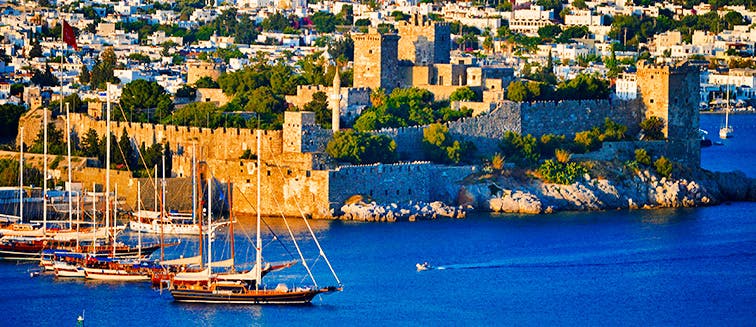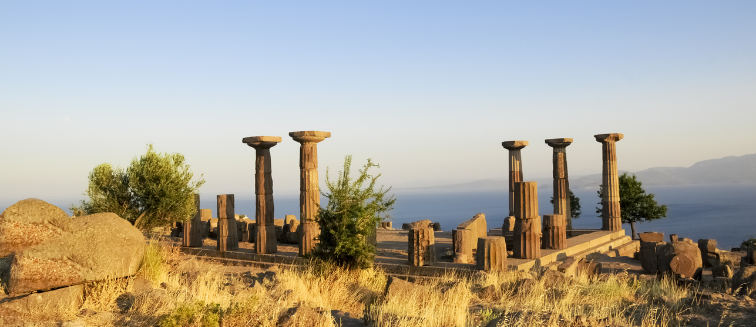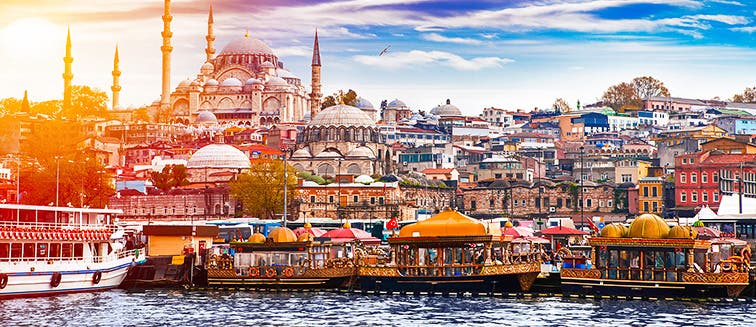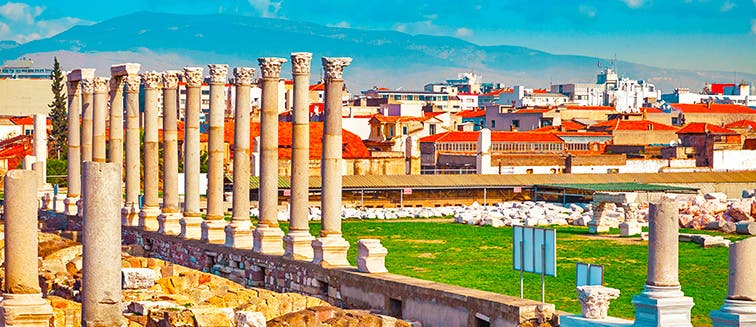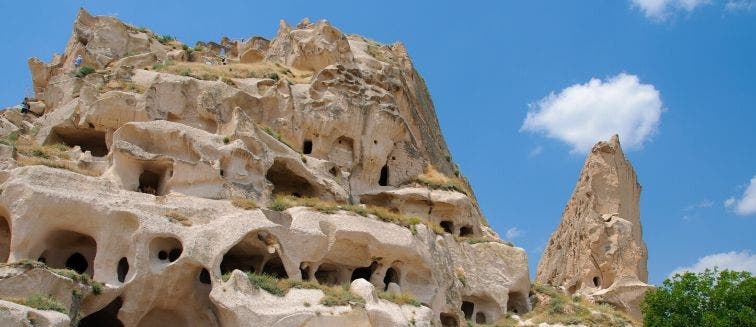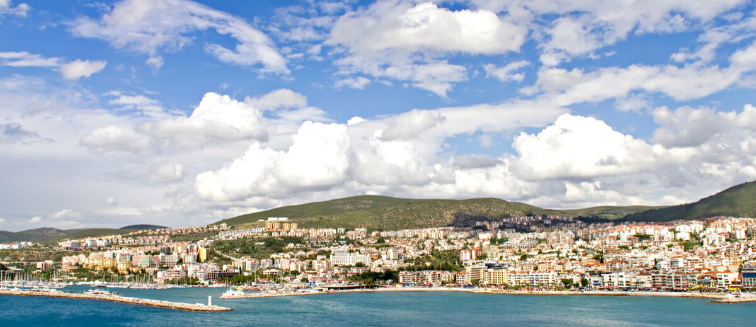Africa
Americas
Asia
Europe
Oceania
Holidays to Europe (103 available)
Albania(2)
Austria(11)
Baltic States(3)
Belgium(2)
Croatia(6)
Cyprus(1)
Czech Republic(8)
Denmark(2)
England(10)
Finland(2)
France(14)
Germany(11)
Greece(11)
Holland(2)
Hungary(9)
Iceland(6)
Ireland(7)
Italy(20)
Montenegro(1)
Northern Ireland(2)
Norway(7)
Portugal(14)
Scotland(4)
Slovakia(4)
Spain(13)
Sweden(1)
Switzerland(4)
Advisors hotline: +1 778-743-2337
Monday - Friday 9am - 9pm EST
Saturday - Sunday: 9 am - 6 pm EST
What to see in Turkey
Pamukkale
Tourist attractions Pamukkale
Turkey is filled with otherworldly landscapes and natural spectacles, but Pamukkale is one of the most exquisite displays of the beauty of nature that you can imagine. White travertine terraces of bright blue water and snow-white limestone decorate the valley sides of Pamukkale, known as the ‘Cotton Castle’. These unique natural formations make a trip to Pamukkale an unmissable highlight of any tour of Turkey. These natural pools were formed as a result of centuries of limestone erosion by thermal springs, and the mineral-rich water of Pamukkale’s pools have long-since attracted visitors thanks to their reputedly therapeutic properties. Hierapolis, the ancient city built around Pamukkale’s natural pools, pays testament to this, as it was constructed around the 2nd-century BC as a spa town to make the most of the warm, mineral-rich waters of this region. If you travel to Pamukkale today you’ll be astounded by the well-preserved ruins of ancient Hierapolis, with its collonaded streets and traditional Roman bathhouses. Many of the hotels in Pamukkale boast special pools filled with thermal spring water, although supplies of the mineral-rich water are restricted in order to preserve the delicate balance of the natural limestone pools. A holiday to Pamukkale combines the natural spectacle of its travertine terraces with the atmospheric streets of its ruined Hierapolis, making it one of Turkey’s most coveted destinations and a UNESCO World Heritage Site.
What to see in Pamukkale
It’s little wonder that Pamukkale is a must-see destination for travellers on a tour of Turkey as there are many diverse sights to explore in and around the town. The ‘Cotton Castle’ of travertine pools are by far the most exciting thing to see in Pammukale. Bright blue pools of thermal water, suspended on the edge of Pamukkale cliff are open to visitors, who can walk and splash through the calcified terraces, although there is a strict no-shoe policy to protect the site from pollution and erosion. Be sure to wear your swimming gear as the higher level pools are perfect for enjoying a relaxing soak and taking in the spectacular views of the rural Denizli. Avoid the crowds by visiting first thing in the morning or late in the afternoon, and keep in mind that this region of Turkey can be surprisingly cold during the winter months, so the best time of year to visit is in the spring or autumn.
Once you’ve conquered the limestone cliffs of Pamukkale it’s time to explore the ancient city of Hierapolis. The Hierapolis Theatre is a good place to start and the breathtaking views across the ruined city and Pamukkale below are well worth the walk. Dating back to Roman times, this two-tiered amphitheatre is remarkably well-preserved. You can even see the remains of a number of luxurious imperial viewing boxes, once frequented by the highest-ranking Romans. Be sure to leave time to explore the ancient streets of Hierapolis when you visit Pamukkale, as its atmospheric, collonaded streets paint a vivid picture of life in a Roman spa-town. Dating back to the 2nd-century BC, if you visit Hierapolis today you’ll see a number of ancient ruins including a necropolis, a Byzantine Church and the white marble Temple of Apollo, built upon the mysterious Plutonium, an underground cave that was once believed to be a gateway to the underworld.
One of the most popular things to do in Pamukkale is to swim in the Antique Pool, once the heart of ancient Hierapolis. Today, constantly refreshed by an inflow of hot calcium-laden mineral water, this former Roman bath is the most popular place to enjoy Pamukkale’s thermal springs. Maintaining an average temperature of 36 degrees celsius, bathers can follow in the footsteps of Roman aristocrats as they float between submerged Roman columns whilst soothing their travel-weary muscles.
If the intriguing ruins of Hierapolis have left you curious to learn more, the on-site Hierapolis Museum is home to some of the original sites most valuable relics including decorative stone reliefs and statues. A wander through this small museum can really help to bring the ancient Hierapolis to life.
Finally, at the foot of the limestone cliffs and travertine pools, charming Pamukkale Village is where you’ll find a good array of accommodation options, traditional Turkish restaurants and tourist-friendly cafes, bars and souvenir shops. Spending an afternoon strolling through its Natural Park or boating on the lake against the backdrop of the ‘Cotton Castle’ is a great way to obtain a different perspective of the glistening white pools.
OUR BEST TRIPS TO PAMUKKALE
YOU ALSO LIKE
Bhutan
2 Trips
India
15 Trips
Maldives
7 Trips
Nepal
5 Trips
Saudi Arabia
1 Trips
Sri Lanka
6 Trips
Turkey
7 Trips
United Arab Emirates
5 Trips
Jordan
8 Trips
Israel
Notify me when available
Armenia
Notify me when available
Uzbekistan
1 Trips
Oman
1 Trips
Lebanon
Notify me when available
Kazakhstan
Notify me when available
Kyrgyzstan
Notify me when available
Qatar
Notify me when available
Bahrein
Notify me when available
Cambodia
4 Trips
Thailand
11 Trips
Vietnam
8 Trips
Myanmar
Notify me when available
Indonesia
7 Trips
Malaysia
2 Trips
Philippines
5 Trips
Singapore
3 Trips
Laos
Notify me when available
China
5 Trips
Japan
10 Trips
Hong Kong
6 Trips
South Korea
5 Trips
Tibet
Notify me when available
Mongolia
Notify me when available
Taiwan
Notify me when available
Tourist attractions turkey
Points of interests
- Trips to Ankara
- Trips to Antalya
- Trips to Bodrum
- Trips to Çanakkale
- Trips to Cappadocia
- Trips to Ephesus
- Trips to Istanbul
- Trips to Izmir
- Trips to Kaymakli Underground City
- Trips to Konya
- Trips to Kusadasi
- Trips to Pamukkale
- Trips to Troy
Other Points of interests
- Trips to Abhaneri
- Trips to Abu Dhabi
- Trips to Agra
- Trips to Al Hofuf
- Trips to Al Ula
- Trips to Al-Hasa
- Trips to Alleppey
- Trips to Amber Fort
- Trips to Amritsar
- Trips to Anuradhapura
- Trips to Arabian Desert
- Trips to Bandhavgarh National Park
- Trips to Beruwala
- Trips to Bikaner
- Trips to Chennai
- Trips to Chitwan
- Trips to Colombo
- Trips to Dambulla Caves
- Trips to Dammam
- Trips to Delhi
- Trips to Dhiffushi
- Trips to Dubai
- Trips to Ella
- Trips to Everest
- Trips to Fatehpur Sikri
- Trips to Fuerte de Agra
- Trips to Galle
- Trips to Goa
- Trips to Ha'il
- Trips to Hegra
- Trips to Huraa Island
- Trips to Jaipur
- Trips to Jaisalmer
- Trips to Janakpur
- Trips to Jantar Mantar
- Trips to Jeddah
- Trips to Jodhpur
- Trips to Jubbah
- Trips to Kajuraho
- Trips to Kandy
- Trips to Kanha National Park
- Trips to Kathmandu
- Trips to Kerala
- Trips to Kochi
- Trips to Koggala
- Trips to Lumbini
- Trips to Maafushi
- Trips to Madain Saleh
- Trips to Madinah
- Trips to Madurai
- Trips to Mahabalipuram
- Trips to Malé
- Trips to Mandawa
- Trips to Matale
- Trips to Nagarkot
- Trips to Negombo
- Trips to Nuwara Eliya
- Trips to Palacio de Jaipur
- Trips to Paro
- Trips to Patan
- Trips to Pench National Park
- Trips to Periyar National Park
- Trips to Pinnawala
- Trips to Pokhara
- Trips to Pondicherry
- Trips to Punakha
- Trips to Rajasthan Desert
- Trips to Ranthambore
- Trips to Rishikesh
- Trips to Riyadh
- Trips to Seeduwa
- Trips to Sigiriya
- Trips to Tabuk
- Trips to Taj Mahal
- Trips to Thanjavur
- Trips to Thimphu
- Trips to Tiger's Nest
- Trips to Udaipur
- Trips to Varanasi
- Trips to Welligama
- Trips to Yala National Park
Countries Nearby
- Armenia Trips
- Bahrein Trips
- Bhutan Trips
- Cambodia Trips
- China Trips
- Hong Kong Trips
- India Trips
- Indonesia Trips
- Israel Trips
- Japan Trips
- Jordan Trips
- Kazakhstan Trips
- Kyrgyzstan Trips
- Laos Trips
- Lebanon Trips
- Malaysia Trips
- Maldives Trips
- Mongolia Trips
- Myanmar Trips
- Nepal Trips
- Oman Trips
- Philippines Trips
- Qatar Trips
- Saudi Arabia Trips
- Singapore Trips
- South Korea Trips
- Sri Lanka Trips
- Taiwan Trips
- Thailand Trips
- Tibet Trips
- Turkey Trips
- United Arab Emirates Trips
- Uzbekistan Trips
- Vietnam Trips
Trip Styles
